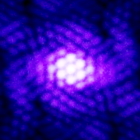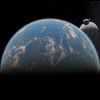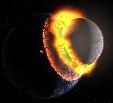|
SpaceEngine Planet Classifications
|
|
| Gondor2222 | Date: Tuesday, 02.09.2014, 20:41 | Message # 211 |
|
Space Pilot
Group: Users
 United States
United States
Messages: 92
Status: Offline
| I think the classification should also indicate bulk composition, with any material composing more than 1% of a planet's mass shown. For solid planets materials would be grouped into three families of "rock", "metal", and "ice"/"volatile". For example, the Earth would be "rocky-metallic" and Titan would be "rocky-icy". For gas planets it should just indicate any chemical present in more than 2%- Jupiter and Saturn are "H-He" while Uranus and Neptune are "H-He-CH4". This system for gas plants also allows for all four of "ice giant/dwarf" and "gas giant/dwarf" because it makes the system "COMPOSITION-MASS".
I also agree with "frigid" as others have said for the coldest temperature class. "Frozen" seems to mean a solid surface of volatiles (which is probably usually the case, as planets far enough from a star to be in this class are probably composed of volatiles) , and "cryogenic" seems a bit too scientific compared to "Scorched-hot-temperate-cold".
Also, will there be a vote on which sets of classnames to use?
|
| |
| |
| Watsisname | Date: Wednesday, 03.09.2014, 13:44 | Message # 212 |
 Galaxy Architect
Group: Global Moderators
 United States
United States
Messages: 2613
Status: Offline
| Quote NickWaterfall (  ) Quote RockoRocks ()
This would not make sense because Ice Giants are not neccesarily smaller than Gas Giants. The name 'Gas dwarf' would imply otherwise.
The largest ice giant in SE is smaller than the smallest gas giant in SE.
Ice giants do, as far as we can tell so far, have a tendency to be smaller than gas giants, but this is not a good reason to call them gas dwarfs. They are not like smaller gas giants. Their composition and formation dynamics are different.
Gas giants have that name because hydrogen and helium gas are the primary contributors to their composition -- they accreted these gases directly out of the protoplanetary disk once they became massive enough. Ice giants on the other hand contain a lot of volatile substances like water and ammonia, which during their formation was in the form of solid "ice". This points to a distinctly different formation region as well -- ice giants form farther away from their suns because it has to be cold enough for the volatiles to condense into solid grains.

|
| |
| |
| SpaceEngineer | Date: Wednesday, 03.09.2014, 16:13 | Message # 213 |
 Author of Space Engine
Group: Administrators
 Russian Federation
Russian Federation
Messages: 4800
Status: Offline
| Quote Watsisname (  ) Their composition and formation dynamics are different.
Actually, at least in the Solar system, gas giants and ice giants was born in the same way - accretion of ice particles into huge protoplanet ~10 Earth masses. After this, their evolution goes by different paths - Jupiter and Saturn was in the most dense region of the solar nebula, with a lot of H and He. They start accreting those gases because they have big enough mass to hold them. Uranus and Neptune accreate only few Earth masses of H and He, because they born in the edge of the nebula. If there would be more gas, they might become a "true" gas giants.

|
| |
| |
| Tenebristhedarkened | Date: Wednesday, 03.09.2014, 23:53 | Message # 214 |
|
Space Tourist
Group: Users
 United States
United States
Messages: 29
Status: Offline
| How would planets such as Kepler-10c rank? It is around the size of Neptune, but, is denser than Earth, thus meaning it might be rocky.
|
| |
| |
| Watsisname | Date: Thursday, 04.09.2014, 01:10 | Message # 215 |
 Galaxy Architect
Group: Global Moderators
 United States
United States
Messages: 2613
Status: Offline
| SpaceEngineer:
Certainly, nobody denies that ice giants would become gas giants if they were more massive and there was more gas available -- those are the conditions for creating a gas giant. The initial formation phase you're describing is also true for all planets (with possible exception of gas giants formed through a disk-instability scenario). But we certainly do not say that Earth is a gas dwarf? 
The point I'm getting at is the divergence of evolution beyond that initial core-accretion. Formation of gaseous envelopes requires availability of large amounts of gas in the nebular environment, and sufficient mass to retain it. Failure of these conditions leaves us with rocky planets near the sun, and ice giants beyond the snow line. Ultimately the evolutionary path is determined by the properties of the disk where the planet is forming -- density, composition, and temperature vary with solar distance. Evolution can be further complicated by planetary migration, resonances and all sorts of chaos.
Added:
Quote Tenebristhedarkened (  ) How would planets such as Kepler-10c rank? It is around the size of Neptune, but, is denser than Earth, thus meaning it might be rocky.
It lies (roughly) here on this diagram and is probably a rocky planet with some water content. Not liquid water of course, but ice under high pressure. According to SpaceEngineer's planet classes it could be called a warm (hot?) superterran.

|
| |
| |
| Jadestar | Date: Sunday, 07.12.2014, 16:32 | Message # 216 |
|
Astronaut
Group: Users
 United States
United States
Messages: 70
Status: Offline
| Will those alternative classification sets be user selectable or will there be just one set chosen for the release and they were presented here for critique?
|
| |
| |
| SpaceEngineer | Date: Sunday, 07.12.2014, 18:23 | Message # 217 |
 Author of Space Engine
Group: Administrators
 Russian Federation
Russian Federation
Messages: 4800
Status: Offline
| 0.972 will have old planet classification (ie not changed).

|
| |
| |
| Jadestar | Date: Monday, 08.12.2014, 05:29 | Message # 218 |
|
Astronaut
Group: Users
 United States
United States
Messages: 70
Status: Offline
| Thanks Space Engineer.
|
| |
| |
| Quontex | Date: Thursday, 09.04.2015, 14:04 | Message # 219 |
 Explorer
Group: Users
 Australia
Australia
Messages: 155
Status: Offline
| I have found a world that got me thinking about space engines planet definitions. There are clear definitions for terrestrial and gas giant world but no classification for the grey area. I submit to Space Engineer that you consider this for patching, I found a world that I think should be a gas Sub-Giant. It has 600atm at the surface but the thing is it's an oceanic so the pressure at the bottom of the ocean as at gas giant levels.
What I'm basically asking for here is a "what if" when the planet is generated like ESI. If it matches certain criteria then it becomes a Sub-Giant.
Images and location of the planet:
RS 0-7-1760765-842-63-6-114409-3748 A8


Edited by Quontex - Thursday, 09.04.2015, 14:06 |
| |
| |
| OBV10U3_NINJA | Date: Wednesday, 29.07.2015, 15:42 | Message # 220 |
 Observer
Group: Users
 United States
United States
Messages: 15
Status: Offline
| NASA Discovered a new type of planet called a gas dwarf. Look it up.
|
| |
| |
| yaqdark | Date: Thursday, 30.07.2015, 01:43 | Message # 221 |
 Astronaut
Group: Users
 Pirate
Pirate
Messages: 53
Status: Offline
| I think your classification is great. Don't change it. Maybe only add some data:
Atmosphere composition? (%s of top 3 gasses? e.g. water, oxygen, ammonia, iron, methane, CO2, etc etc.)
Surface composition? (% rock, % metal, % heavy metal, % water/ice)
Calculate colour of surface and atmosphere from data.
Edited by yaqdark - Thursday, 30.07.2015, 01:43 |
| |
| |
| Alek | Date: Thursday, 30.07.2015, 20:55 | Message # 222 |
 Pioneer
Group: Users
 United States
United States
Messages: 326
Status: Offline
| Quote yaqdark (  ) Surface composition?
And maybe, if you change colors according to surface composition, then maybe generate how much Iron there is, so we might find a few planets like Mars?
Living among the stars, I find my way. I grow in strength through knowledge of the space I occupy, until I become the ruler of my own interstellar empire of sorts. Though The world was made for the day, I was made for the night, and thus, the universe itself is within my destiny.
|
| |
| |
| OBV10U3_NINJA | Date: Friday, 31.07.2015, 00:13 | Message # 223 |
 Observer
Group: Users
 United States
United States
Messages: 15
Status: Offline
| Quote Alek (  ) ...then maybe generate how much Iron there is, so we might find a few planets like Mars?
I have actually found a lot of mars-like planets.
Example -
|
| |
| |
| AeroWolf | Date: Sunday, 20.12.2015, 19:14 | Message # 224 |
|
Observer
Group: Users
 United Kingdom
United Kingdom
Messages: 13
Status: Offline
| Is this all the planet classifications or are there more that haven't been added yet?
Lenovo g500s Core I3 2.4ghz dual core, 4GB ram, Intel HD 4000 graphics :(
|
| |
| |
| Alek | Date: Monday, 21.12.2015, 01:17 | Message # 225 |
 Pioneer
Group: Users
 United States
United States
Messages: 326
Status: Offline
| Quote AeroWolf (  ) Is this all the planet classifications or are there more that haven't been added yet?
If you want a list of most classes...check out my thread xD
Living among the stars, I find my way. I grow in strength through knowledge of the space I occupy, until I become the ruler of my own interstellar empire of sorts. Though The world was made for the day, I was made for the night, and thus, the universe itself is within my destiny.
|
| |
| |